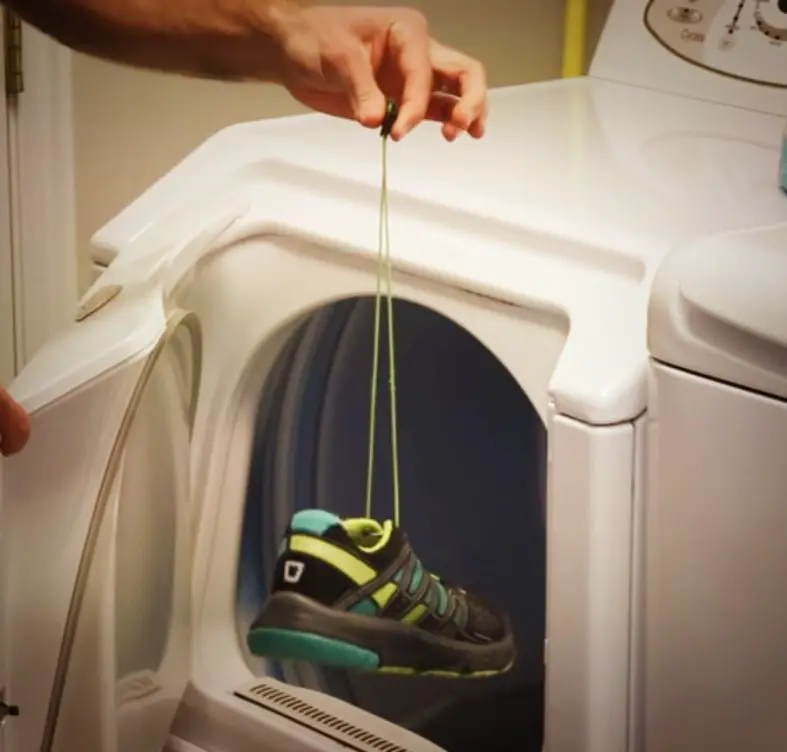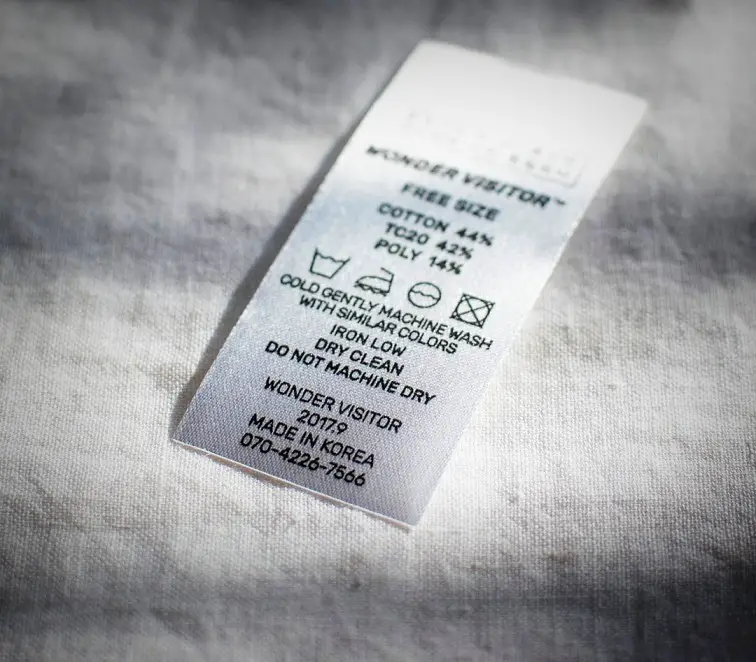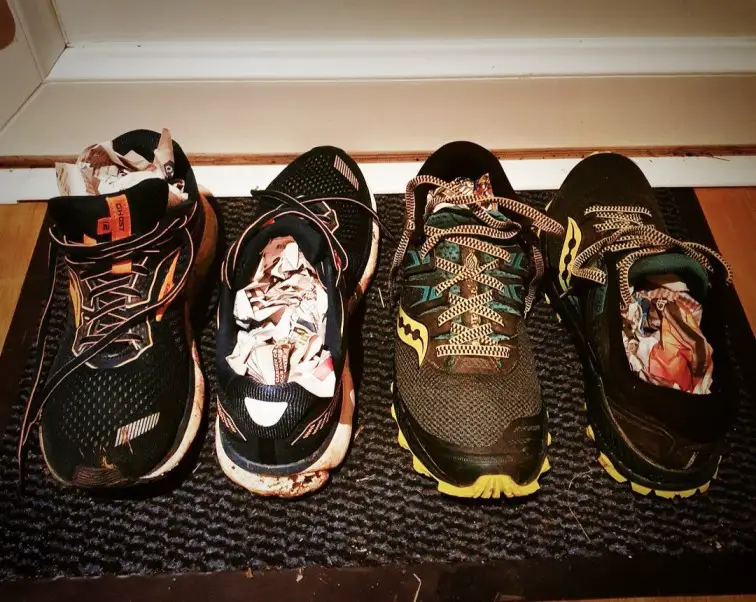Keeping your shoes clean is essential for maintaining their appearance.
However, drying them after washing can be a time-consuming process.
The question is “Is it ok to put shoes in the dryer?”
If you’re in a rush and need to wear them on the same day, you may consider putting them in the dryer.
While this method can expedite the drying process, it’s important to note that it can cause damage over time.

To ensure the safety of your shoes, here are some guidelines to follow when using the dryer:
Choose the low-temperature setting
To avoid damaging your shoes, always set the dryer to a low heat setting.
High temperatures can loosen the glue and overheat the rubber, leading to potential damage.
Remember to select the appropriate temperature before starting the dryer.
Add old clean towels
Place a few old clean towels in the dryer along with your shoes.
This not only helps speed up the drying process but also reduces the noise generated during drying.
It’s important not to rely on this method too frequently, as it can cause damage to your shoes.
However, it’s worth noting that putting shoes in the dryer is generally not recommended.
Heat produced by the dryer can cause rubber soles to warp or shrink.
Certain shoe brands may allow drying with a dryer, so it’s best to check the labels for instructions specific to your shoes.
Some brands may provide instructions to remove insoles or use special covers for drying, but this may not be applicable to all shoes.
When considering whether to put your shoes in the dryer, there are a few factors to consider:
You May Also Like – The lifespan of a Running Shoe: Things you should know
Check the care label

Look for the care label on the inside of the shoes or the tongue to determine if your shoes are suitable for drying in the dryer.
Materials such as leather, suede, or gel-filled inserts can be damaged by the heat, so it’s important to check the label and identify the materials used.
Consider the material
Different materials, such as leather, suede, foam, rubber, plastic, textiles, and synthetics, require different care.
If your shoes contain leather, suede, or fur parts, it’s best to avoid using the dryer altogether, as the heat can cause damage.
When in doubt, assume that your shoes are not suitable for the dryer to prevent accidental damage.
To dry your shoes properly without using a dryer, here are some alternative methods
Dry shoes with newspaper
If you want to dry your shoes without risking any damage, using newspaper can be an effective method.

Remove the insoles (if present) and stuff the shoes with rolled newspaper to absorb moisture.
Wrap each shoe with 2-3 sheets of newspaper to complete the drying process.
Check the condition of the newspaper every few hours and replace it if it becomes damp.
Dry shoes with a fan
Using a fan can help accelerate the drying process.
Hang your shoes from a rack using wire hooks, ensuring the inside of the shoes faces the fan and the soles face outward.
Take care to avoid the cords coming into contact with the fan blades.
Monitor the drying progress and periodically check the shoes.
Dry shoes using the fridge
Stuff the shoes tightly with newspaper to transfer moisture and prevent mold.
If your refrigerator has a heated rack, hang the shoes behind it so that the soles are near the heat pipes.
Allow them to dry for half a day and then transfer them to an open-air environment to complete the drying process.
Also Read – Washing Geox Shoes: My Personal Experience and Cleaning Tips
Dry shoes with sunlight
Placing your shoes in direct sunlight is a natural and effective way to dry them.
Remove the laces and open the tongue to ensure sunlight reaches the entire surface, including the tip of the shoes.
Remember, wearing wet shoes for extended periods can lead to foot problems such as Trench foot or immersion foot syndrome, bacterial or fungal infections, and blisters.
It’s crucial to change into dry shoes and socks if your footwear gets wet, especially in cold weather conditions.
In conclusion, while it’s not necessary to wash and dry your shoes frequently, occasional cleaning is beneficial.
If time permits, it’s recommended to air dry your shoes with something like paper stuffed inside to help maintain their structure.
If you’re in a hurry, you can try one of the alternative drying methods mentioned above.
Always refer to the manufacturer’s instructions for specific guidance regarding drying your shoes.
We hope you found this article informative and helpful.
If you have any questions or feedback, please feel free to share them in the comments section below.
FAQ
Are there any risks or potential damage to shoes when using the dryer?
While drying shoes in the dryer is faster than air drying, it can potentially cause damage over time. High temperatures can loosen glue and overheat rubber, leading to warping or shrinking of rubber soles. It’s important to use caution to minimize the risks.
Can all types of shoes be safely dried in the dryer?
Not all shoes are suitable for drying in the dryer. It’s best to check the care label of your shoes. Shoes with leather, suede, or fur parts should generally be avoided in the dryer. Some shoe brands may allow drying with a dryer, so checking the labels is essential.
How should I prepare my shoes before putting them in the dryer?
Before placing shoes in the dryer, it’s recommended to loosen the laces and tie the shoes together. This prevents them from banging against the dryer walls. For shoes with laces, place them toe-down, holding the laces against the top of the door. Avoid drying shoes without laces to prevent potential damage.
What are the alternative methods for drying shoes without using a dryer?
If you want to avoid using a dryer, there are alternative methods. You can stuff the shoes with newspaper to absorb moisture or place them near a fan to facilitate air circulation. Additionally, drying shoes in sunlight can be effective, especially for sneakers.
What should I consider before deciding to use the dryer for my shoes?
Before using the dryer, consider the material of your shoes. Leather, suede, and gel-filled inserts can be damaged by the heat. Always check the care label inside the shoe or on the tongue. When in doubt, assume they are not suitable for the dryer to prevent accidental damage.
How long does it typically take to dry shoes in the dryer?
The drying time depends on several factors, including the shoe material, size, and moisture level. Setting the dryer to low heat and running a full cycle is recommended. If the shoes are still damp, you can extend the drying time by an additional 20-30 minutes.
Can I use a high-temperature setting on the dryer for faster drying?
Using a high-temperature setting on the dryer is not recommended for shoes. It can lead to damage by loosening glue, overheating rubber, or warping the shoe structure. To avoid potential harm, always set the dryer to a low-temperature setting.
What precautions should I take to avoid damaging the shoes in the dryer?
To prevent damage, add a few old clean towels to the dryer with your shoes. This reduces noise and speeds up drying time. Avoid drying shoes in the dryer too often, as it can cause damage. Always check the care label and use the low-temperature setting to protect your shoes.
Are there any additional tips or recommendations for drying shoes effectively?
Yes! If you prefer alternative drying methods, you can use newspaper to absorb moisture effectively. Also, avoid wearing wet shoes for an extended period to prevent foot problems and potential infections. Properly maintaining the cleanliness of your shoes is also important.